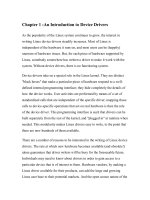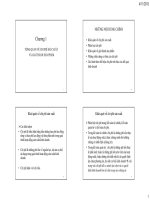Lecture Management of retail buying – Chapter 1: An overview of retail buying
Bạn đang xem bản rút gọn của tài liệu. Xem và tải ngay bản đầy đủ của tài liệu tại đây (313.28 KB, 7 trang )
Copyright © 2006 by John Wiley & Sons, Inc. All rights rese
Ch. 1: An Overview of Retail Buying
• The responsibilities of buyers & merchandise
managers
• Skills & personality traits for success in this
field
• How different types of stores are organized to
meet their buying needs
• The pros and cons of centralized
merchandising
• Opportunities for women in this field
Copyright © 2006 by John Wiley & Sons, Inc. All rights rese
Steps to Anticipate Customer Demand
• Study consumers &
their purchasing
decisions
• Use research to target
customer groups
• Determine quantity &
timing of retail buys
• Find & study the
vendors who can
provide what you need
• Handle the logistics:
packaging, shipping,
storing, pricing, entry
into store database, etc.
• Work cooperatively on
advertising & display
• Maintain & interpret
database
• Watch the competitors
Copyright © 2006 by John Wiley & Sons, Inc. All rights rese
“Are you cut out to be a retail buyer?”
Traits and Skills for Success
•
•
•
•
Decisionmaking skills
Drive
Creativity
Critical, analytical,
conceptual skills
• Financial savvy
• Organizational skills
• Communication skills
• Managerial or
“specialist”
capabilities
• Trading acumen
Copyright © 2006 by John Wiley & Sons, Inc. All rights rese
Planning & Control: Functions of a
Merchandise (or Merchandising) Manager
• Checks and
• Makes longrange
approves any
plans for stock
returns to vendors
levels, margins, ad
• Approves any price
budget
changes, checks
• Checks sales results
prices with long
against the plans
range plans
• Controls OTB
• Approves ideas for
budget
sales events and
promotions
• Checks & counter
signs large orders
Copyright © 2006 by John Wiley & Sons, Inc. All rights rese
StoreLevel Buying Systems
• Warehouse Requisition Plan
Store carries sufficient stock, “requisitions” more as needed
• Approved Resource List
Stores choose from list of “approved” goods & vendors
(also called Price Agreement Plan)
• Opening Stock Distribution Plan
Department manager controls “opening” stock & reorders;
retail buyer augments with new items
• Automatic OpentoBuy
After initial buys, each department has a budget for
reorders that (theoretically) cannot be exceeded
Copyright © 2006 by John Wiley & Sons, Inc. All rights rese
Centralized Merchandising
PROS CONS
• Steady flow of merchandise to
stores
• More reliable forecasting
• Better “big picture” of what’s
selling (& not selling)
• Centralized records
• Quality control
• Cost advantages
• Better stock control
• Leaves buying to the buyers,
not store or dept. managers
•
•
•
•
Hard to adjust “big picture”
orders to local store needs
Requires high degrees of
cooperation and
communication
Difficult to maintain an
informed, enthusiastic sales
organization
Requires clearcut job
descriptions about roles &
authority
Copyright © 2006 by John Wiley & Sons, Inc. All rights rese









